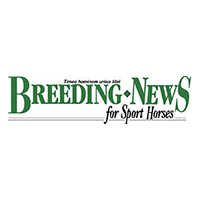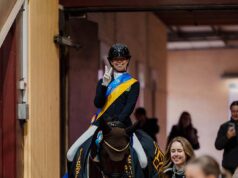By Christopher Hector
Continuing Christopher Hector’s four-part series of the greatest showjumping mares of all time. This month we ask Thomas Nissen, who retired at the end of 2020 after 32 years as breeding manager of the Holsteiner horse and the Verband’s director, having taken over from Gerhard Gramann in 1988 following his university graduation.
Dr. Nissen had been always a promoter of the targeted use of outside stallions, especially English Thoroughbreds and French sires which had great influence on refining and modernization in the Holsteiner horse. Here is his response to my request for the five best mares and, not surprisingly given the key role the Holsteiner has played in the development of jumping breeding throughout the world, he came up with a rather larger list, saying 'take your pick they are all top mares:
• Wodka II (Lord x Ramiro, Stamm 1916) – best stallion sons: Clearway, Conway I and II, and Arturo
• Gofine (Ramiro x Ladykiller xx, Stamm 2472) – Contender and Cornetto
• Zivia (Calypso II x Maestose xx, Stamm 6691) Cassiano, Carambo, and Calazio
• Waage I (Calypso II x Royal Wash xx, Stamm 4965) Clinton I and II, plus Hirtin/Chica Bay – dam of Levisto
• Ungarin III (Fernando x Roman, Stamm 4063) Lambada and Jefferson
• Valeska IV (Fernando x Lord, Stamm 318D2) Corofino I and II, and Camiros
• Deka (Consul x Matador, Stamm 730B) Gonzales, Caletto I, II, and III
• Taura (Lord x Raimond, Stamm 890) Cesano I and II, and Ringo Star – same Stamm as Casall
• Furgund (Colombo x Herwin, Stamm 7673) Calando I to V
• D-Troja (Calypso I x Ladalco, Stamm 223B) Cleveland, De Kooning – same Stamm as Colman, Camposanto, and Conello
Other top-mares: Wisma (Caletto II) – Cassini I and II; Tabelle (Consul x Heissporn) – Calypso I to VI; Option (Lord) – Coriano; Folia (Maximus) – Capitol I.
Our choice from Thomas Nissen’s list
So, let’s go with Gofine (we cannot ignore Contender or for that matter, Cornetto); Deka, the dam of the Caletto brothers; Valeska IV; Tabelle (bearing in mind the influence of Calypso II in the Hanoverian book); and, finally, Folia, since for so long jumping breeding in Holstein has been balancing the 'careful C' of Cor de la Bryère with the 'power C' of Capitol.
Gofine (1970)
Gofine was by the Holsteiner Ramiro, who was one half of Léon Meleichior's outcross breeding program – his largely Gotthard mare base was bred to Ramiro, the pride of Holstein, and Almé, the French champion. This, Mr Melchior believed, would bring hybrid vigour. He was later to move away from the theory outcross and to breed tight instead, covering Ratina Z with her full brother, Rebel Z I to produce Rex Z.
Ramiro was by Raimond, by the Anglo Arab Ramzes out of a mare by the Holsteiner Fanatiker. Ramzes was foaled in 1937 in Poland, and was by the Belgian-bred Thoroughbred – and successful racehorse – Rittersporn xx, who was a grandson of the great French Thoroughbred jumping sire, Le Sancy. Ramzes was out of the Shagya Arab mare, Jordi. During the war, Ramzes was stabled at the Polish Janow Podlaski Stud, where he was a popular riding and carriage horse. With the Russian forces advancing, the Polish studs that were under German occupation were relocated to Germany, and Ramzes was one of the horses that crossed the border. He was purchased by Clemens Freiherr von Nagel, who bred sport horses at his property in Vornholz in Westfalia. He knew Ramzes from his time as director of the Polish Racot Stud during the war.
The Westfalian studbook was not impressed with Ramzes, so he stood at the Holstein Stud in 1951 and 1952, to refine the heavy Warmblood horses of the area. The first foals that were born in Holstein in 1952 were disappointing, they were lightly built, not very big and difficult to sell – many ended in the slaughter house. It was also difficult for his sons to be licensed, their cannon bone circumference of around 20 cms was considered very fine in an era where 24 cms was a more common measurement for stallions.
But his jumping offspring from that first period in Holstein turned the tables. They were stars: Retina, ridden by Fritz Thiedemann, Romanus with Hans Günther Winkler, Ramzes XIII with Kurt Jarasinkski, and Ramona with Alwin Schockemöhle, established the fame of Ramzes in Holstein, and resulted in him standing there for two more seasons, in 1959 and 1960.
Four licensed stallions were bred in the second stud period in Holstein: Roman, Rigoletto, Raimond, and Rhenus. Rigoletto was sold to the Netherlands, while Rhenus ended his days in the circus tent. Roman became a good competition horse and an excellent sire of broodmares. Raimond was a more attractive type than Roman and sired over 120 daughters and eight stallions, but of these, only Ramiro was a success... To read the complete article you need to be a subscriber
CLICK HERE TO SUBSCRIBE TO BREEDING NEWS
SUBSCRIBERS CAN READ THE COMPLETE ARTICLE BY LOGGING IN AND RETURNING TO THIS PAGE




